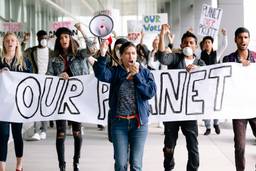
Everyone’s got a metaphor, and ours was the potluck dinner. If we were going to build a climate change movement, and we didn’t have any money or any organization, how could we do it? We decided to throw a party. Invite our friends. Have them invite their friends. See what happened.
And you know what? It worked. On April 14, people around the country will call for the United States to “Step It Up” and reduce carbon emissions 80 percent by 2050. This will be the largest coordinated environmental protest since Earth Day 1970 heralded the onset of a new mass consciousness about the fragility of the planet’s ecosystem. This is the emergence of an actual movement against global warming, something that’s been missing for the two decades we’ve known about this problem – a movement that, because of the nature of the problem, will need to go deeper than environmentalism has gone before. Techno-fixes only go so far with climate change; this movement will need to take on culture, lifestyle, economics. There is no guarantee it will triumph, but it’s almost certain to be interesting.
— — — — — — —
Last summer, I found myself despairing. True, Hurricane Katrina had blown down the door and Al Gore had walked through it with An Inconvenient Truth. More people now knew about climate change than ever before. But it wasn’t changing the politics of the issue. In Washington, Sen. James Inhofe (R-Okla.), the chair of the Subcommittee on Clean Air, Climate Change and Nuclear Safety, said global warming was a “giant hoax.” In a July 2006 interview with the Tulsa World, he compared environmentalists with Nazis and their use of “the Big Lie.” “You say something over and over and over and over again, and people will believe it, and that’s [the environmentalists’] strategy,” he said. “Everything on which they based their story, in terms of the facts, has been refuted scientifically.”
I had been writing and speaking about global warming since 1989, when The End of Nature, my first book on the subject, came out and was serialized in the New Yorker. But I was struck by how little those of us who cared had accomplished – Americans have continued to increase their carbon emissions about a percentage point each and every year. Meanwhile, the scientific evidence was increasingly dire, the degradation of the earth’s physical systems accelerating.
In my despair, I called a couple of old friends who live near me in Vermont. “Why don’t we walk up to Burlington?” I asked. “We can sit in at the federal building and get ourselves arrested, and maybe it will make a little noise in the newspaper, and at least we’ll have done something.” They were good friends, so they agreed to go. But one of them bothered to actually call up to the Burlington Police department, only to find out that in that mellow outpost there was no chance we’d get arrested. They’d let us sit there on the steps forever. Maybe if we set something on fire we’d get the attention we sought – but, oh, think of the carbon emissions!
Anyway, we decided to convert our little tantrum into something a bit nobler: a march, or, better yet – a climate change pilgrimage. We’d march on the shoulder of the two-lane highway; we’d hold meetings every night on town greens; we’d camp in farmers’ fields along the way. And so we started asking people if they wanted to join us. In early August, a team of Middlebury students started doing the down-and-dirty, where’s-the-porta-potty type of organizing. On Aug. 31, we stepped off from Robert Frost’s old writing cabin in the Green Mountains. There were 300 of us that first day. Five days and 49 miles later, when we reached Burlington, we’d grown to 1,000, an impressive turnout in the nation’s second smallest state.
This was enough to change the dynamics of the issue. Everyone running for Vermont’s open Senate and House seats, from socialist Senate candidate Rep. Bernie Sanders to his right wing opponent, Vermont’s richest man, Richie Tarrant, publicly endorsed legislation sponsored by then-Sen. James Jeffords (I-Vt.) that calls for 80 percent cuts in emissions by 2050 – the most ambitious climate change legislation yet proposed on Capitol Hill. It reminded us that you don’t need 51 percent of the people supporting something – you just need an organized group of people who really care.
But here’s the shocking part. The newspapers said that the thousand people we’d assembled was the largest gathering that had ever happened in the United States about global warming. Yes, you read that right. Global warming is arguably the biggest problem we now face, and almost nobody in the United States had done anything political about it.
Not because people didn’t care: Everyone we asked to march said yes. It’s that no one had ever asked them before. The climate change movement is peculiar. It has scientists and engineers and economists, all of the wonderful superstructure that a movement requires, but no mass mobilization to support them. That’s what we need to change. Observers have always said that an uprising about climate was unlikely because few Americans were direct victims (yet) and all of us were in some sense beneficiaries of cheap fossil fuel. But what the march in Vermont told us was that the times had changed.
— — — — — — —
In the months that followed, a few of us – me and six newly minted Middlebury grads – began trying to outline a national action. We considered a march on Washington – but, once again, the carbon emissions! Our experience in Vermont helped us understand how powerful it was to speak to our senators and representatives in their districts. So we hatched a plan: We would get people to stage rallies in the places they lived, or the places they loved, on the same day. Not Earth Day, April 22, because we didn’t want to step on the inspiring work people were already doing for that day. Instead, we’d start the weekend before, as a kind of lead-up – and as a reminder that we need more than one day a year to think about the planet.
Those actions would take place in city parks and on church steps. And some would be staged in truly iconic places, which would remind anyone who heard about them of what was at stake. We raised enough money to build our rudimentary Web site, www.stepitup2007.org, and then, in mid-January, started sending out e-mails. Our fondest hope? That by April 14 there might be a couple of hundred rallies scheduled around the country.
I’m writing these words on March 15. After 10 weeks of organizing, we have more than 900 Step It Up rallies scheduled, a number that increases by the hour.
What happened? We merely sent out invitations to a potluck. But people, desperate to do something, anything, to start stemming the tide of the coming environmental disaster, responded with not only their heads, but their hearts and hands.
— — — — — — —
First to step up have been the national environmental groups. There’s been a lot of talk in recent years about “the death of environmentalism” and the big dinosaur green groups. Some people complained they had turned into mere fundraising machines, or become captives of the Beltway. But that is simply not true. The Sierra Club, the Natural Resources Defense Council, the National Wildlife Federation, among many others, have all committed real efforts to organizing Step It Up rallies, engaging regular people rather than just making technocratic recommendations.
Local environmental groups too – the wonderful stew of “Save the _____” groups that have done such powerful work over the years – understand that the future of the places they love can’t be guaranteed by them alone. Raise the temperature a few degrees, bring the ocean a few feet higher, and the bay/swamp/forest is going to be wrecked no matter what.
But it’s not simply traditional environmental groups who have joined the cause. Churches have responded in impressive numbers as well. A founder of the Evangelical Environment Network, Cal DeWitt, forwarded our appeal around that thriving web of seminaries and colleges. The Christian Century, the magazine of mainline Protestantism, put a big story on the cover. Sojourners, the radically engaged gospel mission, sent out an e-mail appeal. And in late February, we heard from a seventh grader who was planning on turning his big bar mitzvah bash into a Step It Up rally. Mazel tov!
But the response that has moved us the most has come from students. Those who think college campuses are dens of apathy and sloth must take note: There’s a movement emerging across the nation’s high school and college campuses, and the politics of climate are at its center. Energy Action, a coalition of more than 30 campus groups, endorsed Step It Up. The fruits of their labor were apparent one day when a digital photo arrived from the Alpha Phi sorority chapter at the University of Texas at Austin: 180 broadly smiling co-eds behind a big Step It Up banner. “We wanted to show it wasn’t just hippies who cared,” they wrote.
Athletes and other outdoors types have stepped up too. In Florida, scuba divers started organizng an underwater rally on a coral reef near Key West – a reef that won’t be there in a few decades if the warming continues. In Wyoming, skiers plan a four-day trip down the state’s highest mountain, Gannett Peak, including a descent of Dinwoody Glacier, which is rapidly melting. Rock climbers will hang banners from Seneca Rocks in West Virginia.
Activists in half a dozen coastal cities plan to paint blue stripes along the streets where the new tide line will be in a warmer world. In Petaluma, Calif., they will mark with yellow tape what would be the high water mark of the Petaluma River should sea levels rise an estimated 6 to 22 feet due to climate change. In Manhattan’s East Village, Girls Gone Green is going to team up with Reverend Billy’s Church of Stop Shopping and march up to Central Park. Others plan to converge on bikes in city centers. In San Francisco, hybrid cars will parade across the Golden Gate Bridge. In New Orleans, citizens will rally along the levees. Seniors in retirement communities, elementary school kids, you name them, they are involved.
Aerial artists are working out ways for protesters to spell out the message with their bodies. In fact, 800 school kids in Park City already have spelled out “Step It Up” against the Utah snow so we could photograph it for our Web site. Photographers have volunteered to provide arresting images, which we’ll be webcasting before the day is over. And then there are the musicians: Working with MUSE/Cool the Planet, we’ve found songwriters aplenty who are writing new tunes. (There’s even a Step It Up anthem from the Gallerists on the Web site.) All of this is music to our ears as history shows that movements that sing are movements that win.
And we need to win. We’ve wasted the last two decades. The scientific evidence now tells us that we can’t wait any longer. We have to send Congress and our state and local legislators a message that is so clear and so unavoidable that they have to sit up and pay attention. The message needs to be heard by corporate leaders, small business owners and everyone in between that this is a matter that will affect everyone’s bottom line in the years ahead. Reducing carbon emissions by 80 percent by 2050 is a minimal demand scientifically. It may be the maximum that’s politically feasible right now, but we’re just laying the groundwork for what’s going to be a long campaign.
Come April 14, we’ll have what’s most important – a real in-the-streets movement that’s able to grow and build, able to buttress the scientific and economic case for change with real political clout. We hope our particular goal is simple enough for people to rally around, strong enough to begin meeting the scientific challenge, and specific enough to keep Congress members from simply making sweet, reassuring noises about climate change. Most of all, we hope we are helping midwife that necessary network of people who understand that once you change the light bulb, you have to go and change the law, and that to change the law, you have to change the conversation.

I hope you found this article important. Before you leave, I want to ask you to consider supporting our work with a donation. In These Times needs readers like you to help sustain our mission. We don’t depend on—or want—corporate advertising or deep-pocketed billionaires to fund our journalism. We’re supported by you, the reader, so we can focus on covering the issues that matter most to the progressive movement without fear or compromise.
Our work isn’t hidden behind a paywall because of people like you who support our journalism. We want to keep it that way. If you value the work we do and the movements we cover, please consider donating to In These Times.








